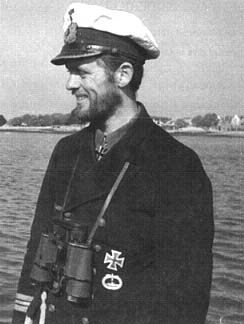Operation Drumbeat
by Guðmundur Helgason
War against America
With the japanese surprise attack on Pearl Harbour on Dec 7, 1941 Hitler was bound by a promise to Japan to also declare war on the US. He did so promptly on Dec 11 and after that all restrictions on German U-boats (which had been attacked and hunted by US convoy escorts in the North Atlantic for the last 5-6 months of 1941 anyway without permission to attack the US escorts) not to attack American shipping were removed. This opened up a whole new field for Dönitz which immediately drew up plans for a devastatingly swift blow on the US eastern seaboard.
Dönitz wanted to strike with 12 type IX boats, the only boats capable of cruising that far. But he was forced to reduce that number to 6 boats due to other engagements of Hitler's preferences of the Gibraltar area. One of the 6 boats marked for this opertation, U-128 was in need of urgent repairs and could not make it in time. Thus only 5 boats sailed.
The drumbeaters disembark
 Kptlt. Reinhard Hardegen after a successful patrol with his U-123 |
U-125 (Folkers) was the first to sail on 18 Dec, 1941, followed by U-123 (Hardegen) on the 23rd and U-66 (Zapp) on the 24th, finally the last two of the Paukenschlag boats, U-130 (Kals) and U-109 (Bleichrodt) sailed together on the 27th. It would take then just over 2 weeks to reach US waters. They were under strict orders not to attack anything on the outbound cruise unless a especially attractive target was located (this meant a big warship like a cruiser, carrier or a battleship, but like Dönitz said "We never let a 10,000 tonner pass us by").
First torpedoes strike
All the boats were to be in position on Jan 13 and begin their attacks at the same time on that date. However, U-123 sank the first ship, the SS Cyclops on the 11th and Kals in U-130 sank two ships the next two days and after that they fell more than one a day as far south as the Cape Hatteras.
The Drumbeat boats ended operations of the coast of America on Feb 6 and headed home. They sank 25 ships for a total of 156,939 tons. Hardegen (U-123) sank 9 ships for a total of 53,173 tons.
America operations continued
This may surprise many of you but Operation Drumbeat really was just the inital wave of 5 large U-boats, Paukenschlag was meant to be a fast and surprise attack on the eastern seaboard of the US, and it succeeded as such. Then there were several other "waves" of U-boats that went into American waters but those don't really count as Drumbeaters.
By the time the Paukenschlag were returning to their French bases in February the next wave of boats had already hit hard In the following waves came many of Germany's most experienced commanders like Topp (U-552), Hardegen in U-123 again, Witt (U-129), Degen (U-701), Schnee (U-201), Mohr (U-124) and Lassen (U-160) to name a few.

A type VII boat returning to port.
In order to make the journey, even with the Milkcow support, some of the smaller VII boats even sacrificed large portion of their drinking water and put diesel fuel in the tanks instead.
Refueling from the Milkcows
During early May the Milkcow U-459 refueled 15 U-boats northwest of Bermuda and thus greatly extended the range and patrol time of the fighting boats, Type IX by 8 weeks and type VII by 4 weeks. This also gave Dönitz the option of attacking much further south than previously possible.
Gulf of Mexico
U-507 (Schacht) sank the first ship in the Gulf of Mexico on May 4, 1942 when he torpedoed the 2,686ton freighter
Norlindo west-northwest of Key West. During the rest of May a ship would be lost roughly every day. The last ship
to be sunk in the Gulf went down on 4 September.
The Caribbean
Convoy systems were started in the Caribbean in July, this convoy system was more complex than the one established on the US seaboard but it still required the assistance of British and Canadian corvettes. 20 ships were sunk in the waters of Panama. See map of U-boat losses in the Caribbean
here.
Convoy system started
In middle of May the US finally started running convoys on the east coast, over 4 months too late. They proved to be effective right from the start like the British had known for more than 2 years at that time and had told the US Navy command again and again.
On 19 July Dönitz withdrew the last two boats operating of Cape Hatteras, U-754 and U-458, and 8 days later he shifted the effort back into the North Atlantic where it had all began and would eventually end.
The statistics
During the first 6 months of the German U-boat offensive out of the US east coast some 397 ships totalling over 2 million tons were sunk, costing roughly 5000 lives. In the process only 7 U-boats (U-85, U-352, U-157, U-158, U-701, U-153 and U-576) were lost. There were only survivors from U-352 (33) and U-701 (7), the rest went down with all hands. 302 Germans were lost on these 7 boats.
This article was published on 31 Mar 1997.
Buy this title at amazon.co.uk £ 16.95 |
Books dealing with this subject include
|


